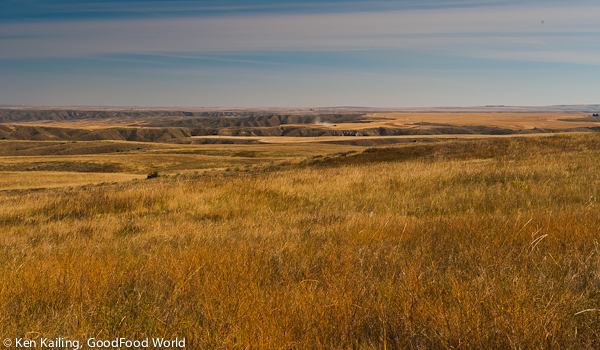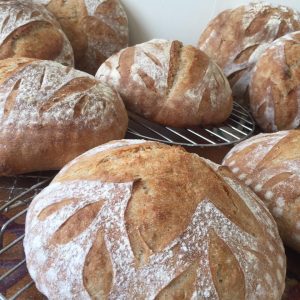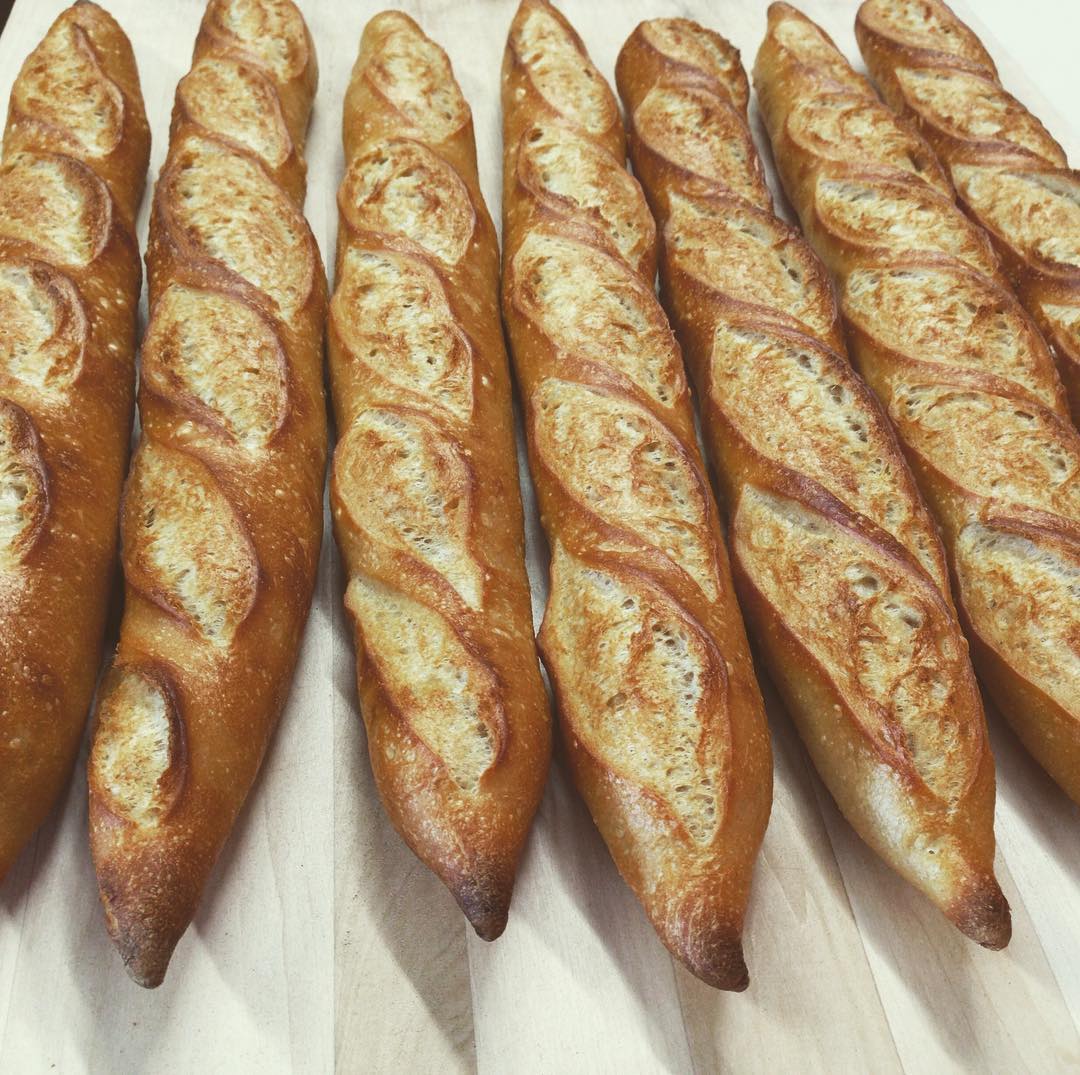Most of the millions living in the Pacific Northwest forget that the drylands of eastern Washington and Oregon on the west of the Rocky Mountains and Montana to the east are also part of the nation’s “bread basket.” They’ve been raised to think that wheat comes from Kansas.
The truth is that eastern Washington and Oregon, and central and eastern Montana produce millions of bushels of wheat, most of which is sold by the train carload to one of just a handful of huge commercial flour mills or is exported. In fact, 85% of the wheat produced in Washington, Oregon, and Montana – and 50% of the wheat produced in the US – is exported to over 70 countries.
Our goal at GoodFood World is to stimulate discussion by reporting on the critical issues affecting the production and use of organic wheat and other grains, especially the challenges to small-scale organic family farms. This is the first in our ongoing series examining wheat, flour, and our daily bread.
Our “National Hymn,” America the Beautiful, opens with the image of endless skies over fields of ripe golden grain that reach to purple mountains on the horizon.

Poet Katharine Lee Bates would probably be appalled to realize that she was eulogizing one of the worst examples of mono-cropping in existence – second only to the carpeting of Iowa with corn.
That idyllic scene represents thousands of years of human development beginning with the gathering and consumption of grass seeds in the Fertile Crescent 17,000 or more years ago, however mono-cropping of wheat has been one of the major contributors to decades of soil and water erosion and water contamination.
And a contributor to one of the greatest environmental disasters of the Twentieth Century: the Dust Bowl of the 1930s.
“Cereal grains” are covering the earth. Wheat – a domesticated grass – is second only to rice as the largest source of vegetable protein for human consumption. Maize (corn) is a close third. Nearly half of the calories of the world’s protein intake comes from cereal grains – mainly rice, wheat, corn, and barley.
From The Source
The first domesticated food crops – the so-called “Neolithic founder crops” include einkorn and emmer (two of the earliest domesticated wheats), barley, lentils, peas and chickpeas, and flax. Samples of early bread wheat containing enough gluten for yeasted bread date from 1350 BC in Greek Macedonia.

The “family tree” of the genus Triticum (wheat) is divided genetically into three groups:
- Wild and cultivated einkorn (Diploids whose genes contain 14 chromosomes): considered to be the “parent” wheat and grown by man as early as 10,000 to 12,000 years ago.
- Wild and cultivated emmer and durum wheat (Haploids – the 28 chromosome group). Durum, the world’s second most widely cultivated wheat, is primarily used to make pasta.
- Spelt and all bread wheat (Hexaploids – the 42 chromosome group). Spelt is a hulled wheat – the hulls are tightly clasped around the grain and must be removed for consumption – and common wheat is “free threshing,” that is, the hulls fall off at maturity. All hexaploid grains are domesticated; none have been found growing in the wild.
The way we use wheat is based on the amount of protein and gluten in the wheat. Pastry flour (from Soft Red or Soft White Wheat) contains weaker gluten, and is good for piecrust, cakes, and other baked goods. On the other hand, it takes a high-gluten flour to make bread that rises well and holds its shape. Bread flour comes from Hard Red or Hard White Wheat. Durum Wheat, very high in protein and low in gluten, is “pasta wheat” used to make semolina flour.
Try using bread wheat for pastry, pastry wheat for bread, or substitute durum-style wheat for either; you may get surprising results! The way we cook and bake evolved with the kinds of wheat we grow. Bread in Europe and the Americas, pasta in Italy, and flat and unleavened breads in the Middle East are examples of historic uses.
Constantly Changing Grain

The discovery of free-threshing wheat simplified the preparation and consumption of wheat. The fact that wheat “self pollinates” made it possible for early farmers to begin selecting seed for planting from the plants that matured the earliest or bore the most and largest grains.
Selection for desirable genetic traits of wheat began with the very first domestication and has never stopped. Wheat came to America in the 16th century and thousands of landraces were developed to match the grain to the local climate and growing conditions, exploding the number of wheat varieties to more than 40,000 varieties currently identified by grain breeders. Wild and domestic grasses crossed with domestic wheat to create new varieties such as Triticale (pronounced (trĭ tĭ cā’ lē), an accidental cross between wheat and rye. In contrast, chemical or mechanical processes are now used to create new varieties never found in the wild.
Consolidation and loss of biodiversity limit the variety of food crops across the entire spectrum of agriculture, including animal varieties. Big Ag – influenced by Big Food – grows fewer and fewer varieties of grain bred to provide specific “quality” traits. Now just a few varieties of wheat account for 90% of the wheat grown in the world.
What is it that Big Ag is looking for? High yield (more pounds per acre), disease and insect resistance, tolerance to stresses such as increased salinity often caused by irrigation, too much rain or too little, and heat tolerance – wheat is a cool season grain. Quality requirements include specific levels of protein, dietary fiber, and components like vitamins and minerals that are considered necessary for good health.

But in retrospect, developments in wheat breeding to increase yield made slow progress. It wasn’t until the late 1950s that the “Green Revolution Gene” was identified, which resulted in huge increases (more than 10 times) in grain production. The miracle simply made wheat and rice shorter. By reducing the amount of energy needed to produce stems, leaves, and other plant matter, more energy is concentrated in the production of grain.
Dwarf wheat varieties have stronger, shorter stems that prevent “lodging,” the tendency for the weight of heavy grain heads to pull full-sized wheat down, destroying it before it can be harvested. The short plants remain standing and, of course, with the increased use of herbicides they don’t need to compete with weeds. Just what the plant breeder ordered! Today as much as 90% of all wheat grown around the world is dwarf or semi-dwarf varieties.
As conventional farmers respond to pressures from Big Ag and Big Food to grow fewer and fewer standardized varieties, we lose the ability to adjust to climate change that is causing temperatures to rise in the American Grain Belt. Wheat is a cool weather plant, requiring moderate temperatures during its germination and growing stages. We also lose the complex flavors that come from landraces that reflect local growing conditions.
The Terroir of Grain
Let’s try a taste experiment! This will require a little shopping…
We want to compare white “supermarket” bread, “whole grain” commercial bread, a “pseudo-artisan” bakery bread, and a locally produced true artisan bread from a small bakery.

Compare the weight, the color, the texture, and most of all – the flavor. What do you find? The supermarket brands are most likely damp, floppy, and flavorless. Why?
Conventional plant breeders are constantly seeking genetic traits that result in higher and higher yields, however they seem to have left out a key quality measure: flavor. When commercial supermarket bread includes high fructose corn syrup, salt, soybean oil, and sugar as standard ingredients (just read your nutrition labels), the flavor of the flour used in baking is not as important.
Much like wine and cheese, the flavors of grain – and the breads made from them – can be unique to a region or even a micro-climate present on a group of farms. Small grain growers in Washington, for example, are experimenting with heirloom varieties. The grains and flours are sold locally to emphasize the concept of terroir: unique flavors developed from local soils and growing conditions.

We grow a lot of wheat in Montana! The good news is that central and eastern Montana is perfect wheat-growing country. The bad news: 85% to 90% of that wheat is exported.
Creative small growers are doing something about it! Farmers are experimenting with local landraces and locally developed varieties in New York, California, Washington, Oregon, and Montana. Combining grain with vegetable and fruit crops on diversified farms brings back some of the beauty and uniqueness to family farm landscapes. Grain for flour, animal feed, or brewing and distilling integrates well with crop rotations now in place in organic production.
Milling The Nutrients Right Out of Our Grain
Most of the millions and millions of pounds of wheat that is not exported whole is milled into flour. Thousands of years ago, women (and some men) crushed wheat and other grain between stones to make flour. A slow process that resulted in rough whole grain flour.
Bread was truly the “staff of life” for both the peasant and the nobleman for centuries. In the Middle Ages (the 5th through the 15th centuries), for example, a majority of the population – mostly poor – ate 2 to 3 pounds of heavy, nutritious bread a day.
Those simple milling stones have evolved into a complex set of machinery that very efficiently turns a nutrient-rich food into a fine powder from which more than 30 essential nutrients have been eliminated. Modern milling removes as much as 30% of the original grain – the outer protective coat, the highly-nutritional bran layer and the wheat germ.
By the 1940s, as a result of these processes, malnutrition became so evident that government sponsored programs were instituted to prevent the high incidence of diseases such as Beriberi and Pellagra. Bread manufacturers began adding vitamins and minerals (primarily niacin, riboflavin, thiamin, and folic acid) back into the baking process. Today white flour is “enriched” with these four nutrients to return the flour to a somewhat nutritious state.
Where does the miller or baker get the replacement vitamins and minerals that once arrived free with the wheat berry? He buys them from big pharmaceutical companies and mixes prescribed amounts into the freshly ground flour.
The Illusive Distribution Chain – Where Have All The Millers Gone?
Unfortunately as the amount of wheat exported grew over the years, the network of local and regional mills that existed 150 years ago virtually disappeared. Consolidation has reduced the number of commercial mills to just a handful of very large operations.

In 1870, there were more than 22,500 “grist” mills in the US, many of them water powered. Grist, by the way, is not a descriptor for a type of grain, but a noun signifying a measure of grain. A grist is defined as the amount of grain brought by a farmer to the mill in a single wagon. Today there are only about 200 flour mills spread across the entire country, most in the eastern half. Cargill, ADM (Archer Daniels Midland), and ConAgra alone control more than half of all milling capacity in the US.
In Montana, the situation is similarly dire. At one time there were as many as flour mills located in nearly every small town in the the state. Today the number processing wheat and other grains grown on tens of thousands of Montana acres can be counted on two hands with fingers left over. While micro-bakeries like Blue Truck Bread, Power MT, can grow, mill, and make bread with heirloom grains grown “down home,” the “middle-sized mills” are simply missing.
Taking Back Our Daily Bread

Heavy, rich, and nutritious bread was once a daily staple; today commercial industrialized bread, produced in fully automated factories, is full of chemical additives and preservatives and too much salt, and has too little nutritive value.
By reconnecting the broken links between local and regional grain farmers, the grain cleaners and millers who process their harvest, and the home and commercial bakers who make it into loaves, we can take back our daily bread. It is not enough to have farmers growing grain as part of their crop rotation or to have artisan bakers turning out dense, nutrient-rich breads, but we have to bring back the skilled millers who grind the grain to flour.
Eat whole grains and artisan bread. Seek out small local and regional grain growers. Buy a small mill and grind your own. Celebrate the terroir of your daily bread!

Read More
The Dust Bowl, Ken Burns, 2012, http://www.pbs.org/kenburns/dustbowl/
Specialty Grains for Food and Feed, edited by Elsayed Abdel-Aal and Peter Wood, American Association of Cereal Chemists, Inc., 2005
Common Wheat, Wikipedia, http://en.wikipedia.org/wiki/Common_wheat
The Wheat Farmer’s Bread and the Baker’s Crop: http://www.irisncw.org/Success-Stories/Bread-and-Crop.html
The Man Who Planted Wheat: http://nwfarmsandfood.com/index.php/the-man-who-planted-wheat
Wheat Researcher Surprised By Taste Test: http://www.capitalpress.com/content/SB-small-grains-062912-art
Wheaty Indiscretions: What Happens to Wheat From Seed to Storage: http://editor.nourishedmagazine.com.au/articles/wheaty-indiscretions-what-happens-to-wheat-from-seed-to-storage
Green Revolution Genes: http://5e.plantphys.net/article.php?ch=&id=355
Agricultural Chemical Use – Wheat, 2009, USDA National Agricultural Statistics Service, http://www.nass.usda.gov/Surveys/Guide_to_NASS_Surveys/Chemical_Use/WheatChemicalUseFactSheet.pdf
Flour milling in Washington — A Brief History: http://www.historylink.org/index.cfm?DisplayPage=output.cfm&file_id=9474
U.S. Food Import Patterns, 1998-2007: http://www.ers.usda.gov/media/157859/fau125_1_.pdf

